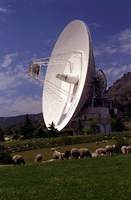|
Listing 1 - 10 of 67 results. Go to Page: 1
2
3
4
5
6
7
| Photo ID: h8taks | Subject: Space | Description |  | Galaxies; Hubble Space Telescope; Stars; Telescope Methods | A famous group of five compact galaxies featured in the film classic "It's a Wonderful Life" appears in a new image from NASA's Hubble Space Telescope. The photo showcases three regions of star birth: the long, sweeping tail and spiral arms of galaxy NGC 7319 (near center); the gaseous debris of two galaxies, NGC 7318B and NGC 7318A (top right); and the area north of those galaxies, dubbed the northern starburst region (top left). The partial galaxy on the far left is NGC 7320. | | Photographer | Location | JPL
Credit Line: Copyright © NASA, JPL | NA | |
Photo Quality | Large |  Available for Commercial Use Available for Commercial Use |
| Photo ID: h8takg | Subject: Space | Description |  | Black Holes; Magnetic Field; Models; Plasma; Simulation; Three-Dimensional Models | This three-dimensional illustration shows how the rotating space around a black hole twists up the magnetic field in the plasma falling toward the black hole. The black sphere at the center is the black hole itself, and the yellow region around it represents the area where space is being twisted. The red tubes depict magnetic field lines threading this twisted space, while the green ones show magnetic field lines which have not yet entered that space. | | Photographer | Location | JPL
Credit Line: Copyright © NASA, JPL | NA | |
Photo Quality | Large |  Available for Commercial Use Available for Commercial Use |
Go to Page: 1
2
3
4
5
6
7
|


 ©
2009 All rights reserved. American Geological Institute, 4220
King Street, Alexandria, VA 22302-1502.
©
2009 All rights reserved. American Geological Institute, 4220
King Street, Alexandria, VA 22302-1502.









